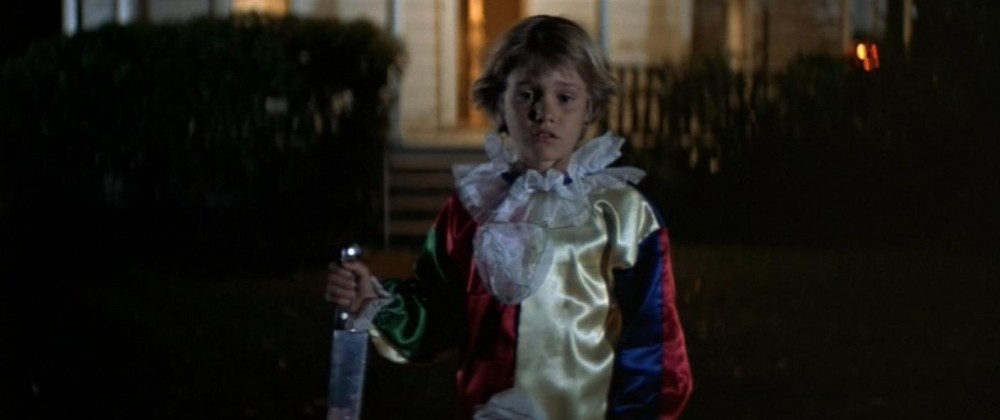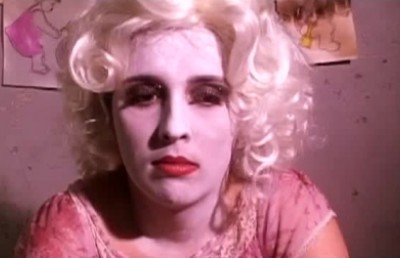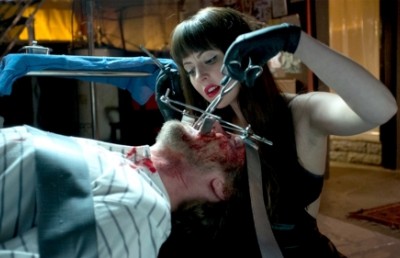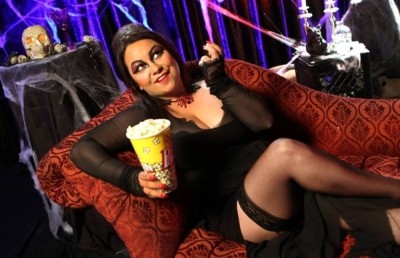Horrifying Whiteness: Slasher Conduct, Masculinity, and the Cultural Politics of Halloween

In Nicola Rehling’s article “Everyman and No Man: White, Heterosexual Masculinity in Contemporary Serial Killer Movies,” Rehling discusses the masculinity concerns in serial killer films with relation to politicized issues that occur in identity critiques. This discourse investigates arguments promoting self-determination among groups of people with shared experiences of social injustice. To Rehling, serial killer critiques have “resulted in concerns that white, heterosexual masculinity, as the universal, dominant, unmarked norm, is an anxiously empty identity that lacks specific content, apart from its assigned role as oppressor” (2). When placed in opposition to a “visually inscribed gender and/or racial otherness,” the visible recognition of difference makes the white male comparatively fighting for legitimate presence (Rehling 2). While I do not consider serial killer and slasher films synonymous, I think the nervous energy of the alienated white male that Rehling finds in serial killer films carries over to the slasher figure—dehumanized for his ruthless attacks upon the victimized protagonist(s). Yet the temptation to write off the slasher figure as a strictly misogynistic monster should be reconsidered in lieu of a more analytical consideration of how he represents the performance of white male anxiety and desire, as indicative of the changing cultural politics of the past 60 years. This represented anxiety refers to the displacement of the American white male as the dominant voice of socio-political power and as the ideological figure of gender superiority in a patriarchal capitalist society.
This article serves to investigate how slasher icon Michael Meyers corresponds contextually to the socio-political constructions of masculinity issues during the decades in which he initially stalks within shadows. John Carpenter’s Halloween (1978) reflects the cultural delegations of power during the 1950s-1970s/80s through which Michael represents the plight of muted masculinity. Acting as a cathartic figure through which the male viewer’s challenged social position can be vicariously avenged, Michael compensates for his social deviance through his violent indifference; he appropriates a position of intimidating authority otherwise denied to him. And Rob Zombie’s 2007 reboot modernizes the evolution of Michael’s masculine aggression through a psychoanalytical approach. Zombie creates a dysfunctional back story in which Michael is empathetically humanized as a young victim of an impersonal, crude, oversexed culture void of yesteryear’s patriarchal values, a void that instigates his psychopathic personality into psychosexual deviance.
In order to contextualize Michael’s violent operations as machinations of a patriarchal structure, it is necessary to classify how patriarchal ideology functions in the horror genre. In his essay “Masculinity and the Horror Film,” Peter Hutchings claims that:
Men who watch and enjoy horror are always already subjects of patriarchy, that is they are located in relation to various institutions, discourses and beliefs which identify, support and perpetuate male power in society. This is the context in which horror operates and it can be argued that, in such a context, the fantasy of disempowerment outlined above takes on a particular significance. (92)
Hutchings specifies that while a man will have the social supremacy when he is the active “subject of patriarchy,” this sense of power must not be misconstrued as being automatically available to him (92). Instead, a man earns this dominance when he abides by the rules constituting these ideological apparatuses: by policing others’ actions to reflect productive reinforcements of gender roles, racial awareness or apprehension, “appropriate” sexual orientation and engagement (read: heterosexual relationships between consenting adults, ideally under the caveat of marriage); and regulating his own self-control through the boundaries of proper conduct (or not misusing his dominant position of power for morally evil reasons). Scholars like Hutchings argue that if a man tries to attain power simply based on “his own unique being,” or his “personal” sense of entitlement, he will not receive collective blessings of respect and support from other members of society. Instead, he will show himself a rebel against order for not playing by societal rules. This concept of power through moderating one’s behavior as well as others is important in reading Michael’s slasher characterization because his daunting presence and unapologetic sadism clash with the social structure. By unabashedly murdering civilians (men, women, and especially pretty young teenage girls), he blatantly ignores man-made laws to protect the living, and makes himself a threatening enemy of the justice system. Hence there is potential conflict in how the viewer responds—enjoyment in seeing the virility of Michael’s masculine performance of power and witnessing the victims’ fears, but also an awareness that unchecked male power is a threat to patriarchal order and must ultimately be contained or eliminated.
In his sociological study Taking It Like A Man, David Savran provides a historical overview of how twentieth-century American masculine constructs shifted over the decades. His explanation of 1950s and 1960s normative masculinities aligns eerily well with the disconnected (and only briefly-established) relationship between young Michael and his family in Carpenter’s film. During the 1950s, a post WWII America faced “a return to conservative social and political values and to strictly enforced gender roles” (46-47). The reformed hegemony emphasized the importance of the nuclear family as a site for instilling honest, cooperative, and productive values that would feed into supporting the capitalistic system (46-47). Normative masculinity at this time was represented through the “organization man,” a figure submissive to “corporate structures in exchange for obtaining a secure place in the organizational hierarchy” (47). He attained this security by exerting loyalty, respect, and cooperation towards his employer and peers at work and towards men in other communities to which he belonged. Yet these amiable traits, so focused on communal cohesiveness, also aligned the organization man alongside traditionally-domestic qualities that prohibited aggressive behavior. Aggressive, individualistic actions pitted him against his common man, making him more like the previously endorsed “independent and entrepreneurial-minded” masculine male (47). One might recognize this normatized masculinity through Michael’s father (Carpenter). Mr. Meyers only appears in the film’s exposition, dressed in a traditional, simple business suit and coat that code as middle-class stability; assumedly, Mr. Meyers is an organization man that is seemingly normal and seemingly successful, given the size and clean, traditional appearance of his suburban home.
Yet in terms of societal expectations of repressed aggression and sexuality, the film implies that Mr. and Mrs. Meyers have failed in policing their children’s behaviors for social acceptability. Whatever parental authoritative position they could or should have held in guiding their son to belong to society has an unlikely chance of penetrating Michael’s disconnected psyche once he commits his first murder. While his father’s appearance codes for the normative man, Michael’s misleadingly normal appearance exemplifies how the unmasked slasher can initially represent the everyday male, but eventually be distinctively identified as the abnormal. His clown costume fits the Halloween spirit assigned to trick-or-treating, complete with clown mask. One might assume that since Michael looks harmless, he must be harmless. Yet his violent use of a real kitchen knife punctures the façade of innocence embedded within the child costume, just as it punctures his sister to death. His stalking and murdering acts define him in opposition with the communal, law-abiding expectations of repressing violent aggression, as well as the innocence and fragility expected of children. This early display of unrepressed aggression suggests how dangerous and deceptive physical normalcy can be in hiding psychological non-normative masculine traits.
Comparatively, America’s 1960s society faced the materialization of new cultural concerns that challenged previous normatized masculinity; a visible explosion of communities were simultaneously criticizing the social injustices imposed upon them by a discourse in which dominance equated with white heterosexual maleness. The Civil Rights, Women’s Liberation, and Gay Liberation Movements vehemently voiced their oppositions to unequal cultural privileges that relegated them into segregated disempowered factions. As these individual groups gained numbers and garnered public attention, the white male figure found himself in a more confined position ripe for criticism. For example, feminism at the end of the ’60s provided a disciplinary voice in which a new vocabulary of phrases like objectification, “male chauvinism,” and “sexism” brought the patriarchal performance of normatized men under the spotlight (Savran 125). The privileged white male was (more) publically demonized as a cultural oppressor; and by questioning his right to power, identity politics chipped away at his legitimacy and threatened that patriarchal capitalistic authority. The culture war attacks made it difficult for white men to define and embrace their identity without being condemned. Incited through frustration, anti-feminist and anti-integration responses increased through which white men identified themselves as the true victims.
Although the slasher represents the repressed in his behavioral monstrosity, the male viewer can temporarily ignore his own social confinement and “feelings of inadequacy” through Michael’s dominating physical presence (Hutchings 84). The slasher can be identified as “‘the other within’ – that is, those fears and desires that the hero has had to repress in order to enter civilized bourgeois society. While the monster, therefore, always functions as an othered figure, s/he always troubles the hero’s identity since s/he represents ‘the return of the repressed’” (Rehling 7). Freud’s psychoanalytical concept is applicable to the slasher configuration of Michael because he symbolizes the alienated individual that is removed from society only to return with a thirst for vengeance. His ability to seem invisible empowers his authority by instilling in his prey a fear of his physical superiority. He could appear at any moment in which the victim lets her guard down. In other words, one must constantly police herself in order to survive (e.g. there is no time for sex, drugs, or otherwise indecent/illegal behavior when you are trying to stay alive; and had you abstain from these activities to begin with, or not associated with people who do, you would probably be safe)—an excessive, traumatic enactment of the normal social expectations of abiding by institutionalized gender roles.
While Michael is non-normative due to his apathy and irrepressible violent inclination, critics have argued that the filmic nature of the slasher stands for an active patriarchal expression against unrepressed female sexuality. He overcomes women, forcing the viewer into his first-person perspective before attacking them with his phallic weapon-of-choice (a kitchen knife) or with an intimately-close strangling. In Laura Mulvey’s seminal piece “Visual Pleasure and Narrative Cinema (1975),” she deconstructs the binary oppositions through which horror films appease the repressed desires of a gendered spectatorship. Mulvey’s work with the filmic “male gaze” applies to the process in which male spectators view the female actress or subject as a spectacle at their semiotic disposal. She roots her argument in the male-dominated structure of Hollywood film narratives in which, “Woman then stands in patriarchal culture as signifier for the male other, bound by a symbolic order in which man can live out his phantasies and obsession…tied to her place as bearer of meaning, not maker of meaning” (par. 2). In other words, the male spectator openly enjoys making the woman on screen the object of his gaze, which is reinforced by the camera’s focus making her easily accessible to the eye.
Mulvey argues that the standard dominance of Hollywood-style film narratives forces the female into a visual stance of “oppression” (par. 3). In Carpenter’s Halloween, teen daughter Judith engages in premarital sexual activity (kissing/making out) while the parents are out. And little brother Michael bears witness to this sexuality, not by merely walking in on it, but through a creepy first-person perspective of watching her and her boyfriend through a window. The viewer is forced to adopt Michael’s voyeuristic position, and the stringent music elevates the scene’s tension by positioning Michael as an outsider to his own home, his own family. After the boyfriend leaves unscathed (pulling his shirt back on, implying that his interaction with Judith got heavier), Michael dons his mask and invades the privacy of Judith’s bedroom. The incestuous undertones surface as Michael sneaks up on a topless Judith who immediately covers herself, an attempt to readopt propriety. The mask obscures the view, but the frame focuses on Michael’s fist as he makes stabbing motions, followed by Judith dropping dead on the floor. While the child figure in horror can often times be rendered as innocuous, impressionable, and vulnerable to whatever danger lurks in the film’s shadows, Halloween infuses Michael with an already-present predisposition to attack youthful sexual awareness, making him the thing in the shadows. There is no explanation provided for why he commits the murder, either; let alone would the viewer expect a six-year-old to respond so violently, period. But rather than treating this moment as a traumatic moment, possibly a site for repression on Michael’s behalf, it becomes traumatic for Judith (and any viewers self-identifying with her). The parents’ silence foreshadows a pessimistic future for their silent-but-deadly son; a future in which the illusion of nuclear family values and organization cannot fully repress non-ideological individualism.
It is appropriate that Zombie begins his 2007 reboot in the 1970s/80s, a period marked “a crisis in confidence” in which the nuclear family is decentered and sexual expression is part of the “free love” culture (Savran 167). Following economic issues, Vietnam, and other factors, American masculinity gained an identity figure that Savran calls the “narcissist,” a victim of the culture wars who “represents a sharply divided subject characterized by his ‘dependence on the vicarious warmth provided by others combined with a fear of dependence, a sense of inner emptiness, [and] boundless repressed rage” (Savran 167). Past the resurgence of feminism, women’s increased employment and infiltration into masculine disciplines like law and medicine made 1980s men realize that “their economic privilege [were] jeopardized” (Savran 191). This construction raised the plight of the American white male whose agency was perpetually threatened as the benefactor of patriarchal factors for too long, and forced into discretionary silence.
Interestingly, the performance of “silence” functions heavily in Michael’s mysterious and frightful conduct. Carpenter renders Michael absolutely mute, so the viewer learns about Michael predominantly from Dr. Loomis’s analyses. By being the “expert” voice to rationalize Michael’s actions rather than Michael explaining himself, Dr. Loomis represents the normatized, credible patriarchal figure of Western Science to stand in and dictate the course of action necessary to stop the deviant slasher, shifting from an initially understanding and empathetic opinion to one desperate to terminate the overly-aggressive threat to the Haddonfield community. Without a voice, a means for communicating his perspective if desired, Michael loses that aspect of agency that, otherwise, allows others to demonize and publicize him as a menace to society. Again, this inability to express one’s identity harkens to the manner in which white men were demonized by both patriarchal institutions and marginalized groups of people; in Michael’s case, his silence might stand as a metaphorical representation of the white male’s muted attempts to have his identity be recognized by a resistant audience.
Zombie’s young Michael possesses a voice, albeit a reserved and passive-aggressive one; this Michael has more overtly-rendered reasons to be aggressive through the issue of bullying. He is the subject of constant antagonism at school by peers, and at home by his mother’s alcoholic boyfriend and his volatile older sister. These persistently hostile relationships take a psychological toll on him as he demonstrates his unrepressed emotions through animal abuse—killing defenseless creatures as a release that is cultural coded for early stages of a potential serial killer (moving from tiny prey to vulnerable human prey). Yet Michael interacts positively and selectively with his mother and baby sister. If men are victimized in horror films, chances are that they are “nearly always marked as unusual. It is as if the presence of a disempowered male poses certain credibility problems and requires special explanation or justification” (Hutchings 91). If Michael is marked as unusual, it is not surprising that he depends on his mother and sister for positive self-identification. As a stripper, his mother’s professional reputation marks her as a literal sexualized object for the male gaze, and Michael protects and values her honor. This may suggest a protective nature rooted in an Oedipal complex of limiting the male gaze upon her to be only his gaze. Michael’s baby sister requires physical protection and care that Michael monitors. Once his own mother succumbs to the societal beliefs that Michael is a monster, drained of her energy to rehabilitate him through kindness, her suicide (and by proxy the baby’s relocation) represent the snapped cords of humanity on which Michael held. The prolonged punitive measures of being stuck in the legal/psychiatric system quicken Michael’s transformation into a despondent, withdrawn being. Zombie’s Adult Michael stops talking altogether, an action that further removes him from normal society—and he reconstitutes his motivation to kill into a motivation to find and reunite with his long-lost baby sister when he discovers she still lives in Haddonfield (regardless of her blatant attempts to stay away from him).
In her seminal slasher analysis, “Her Body, Himself,” Carol Clover makes a valuable proposition of the slasher’s physical traits, relating how his appearance corresponds with an overall dehumanizing effect of barely-human-and-not-at-all-humane. She describes that:
They may be recognizably human, but they are only marginally so, just as they are only marginally visible—to their victims and to us, the spectators. In one key respect, however, the killers are superhuman: their virtual indestructibility. …Michael [in Halloween] repeatedly rises from blows that would stop a lesser man. (30).
His stealthy mobility and persistence make him “superhuman.” Without the need (or, even, the ability) to speak, Michael stalks his prey with the grace and eerie silence of a ghost, always overtaking his victims by surprise. His ability to pop up in corners, in shadows, without making a sound and within the blink of an eye makes him seem omnipresent. Referring back to the introductory Rehling passage, his silence and stealth are like patriarchy manifested with an optimistically re-empowering identity, a cultural comeback to counteract the emptiness and unmarked-ness of white masculinity. He may not always be heard or seen both literally and metaphorically, but it is this failure on his targets’ parts (their disbelief, obliviousness, or misjudgment in his power) that gives Michael the upper hand to strike against them. His supernatural determination (always watching, always stalking, and never sleeping) is a powerfully disturbing image. If they fail to uphold the expectations of patriarchal values, he may haunt them next; and if they are friends or family affiliated with guilty participants, in the wrong place at the wrong time, they are not safe, either.
Savran discusses the composition of the psychopath (“aka the rebel without a cause”) that is applicable to both Michaels’ constructions:
The (male) narcissist….is the product of an unfortunate weakening of a ‘patriarchal authority’ in a feminized culture. Because he no longer has ‘loved and respected’ figures to emulate, he retreats to fantasy and develops a ‘sadistic superego’ (derived from the id) that assaults his now masochistic ego. A hapless victim of the ‘social changes’ wrought by “[t]he new permissiveness.” (168)
This repression of normatized masculine behavior relates directly to the theme by which slashers represent non-heterosexual or asexual natures outside of hegemonic norms. Michael is flawed for being “virginal or sexually inert,” an abnormal tendency within the patriarchal expectations of having to repress sexual desire rather than incite it. Perhaps his behavior stems from his biological father being dead, leaving him without a positive male role model in sight. At home, he receives verbal abuse by Ronnie the crass alcoholic surrogate father and Judith the crude promiscuous sister. They each refer to him with a disparagingly homophobic and misogynistic barrage of extremely inappropriate language such as “ball licker” and “faggot,” telling him that “he runs around like a little bitch.” Michael’s contemporary coming-of-age story may be disturbing because of his blatant disregard for killing people, but it is also empathetic through the recognition that he has been oppressed to a breaking point for embodying a nontraditional representation of what is deemed normal—without humane treatment, he loses whatever sense of humanity was fostered.
The slasher’s mask comes to represent a visual marker of performance by rendering the wearer’s true face obsolete. It acts as a façade that erases human facial expressions. Yet it also acts as a projection of the repressed male’s anxieties of social and physical power, and the threat of killer’s latent violent potential. Lonely and self-degrading of his appearance, Zombie’s ten-year-old Michael retreats from his drab reality by producing masks, telling his mother, “I like the mask because it hides my face…my ugliness.” Dr. Loomis analyzes the reliance upon the facial barrier as a way “to create a mental sanctuary in which he can hide within himself and from himself” (Zombie). Initially made from paper and black pen scribbling, Michael’s obsessive construction of masks evolves in sophistication, each one worn with disturbing care. The act of nonstop masquerading symbolizes his growing detachment from humanity, providing an outlet to embrace his immediate emotions without concern for social repercussion. He has been conditioned by society to devalue himself, to see his abnormal nature as “ugly,” and he responds to this negative by effacing himself. I believe that Michael cannot fully complete his performance of masculinity-through-violence without wearing a mask because it allows him to completely eradicate his human identification. Zombie’s Michael pulls his mask on and off while attacking the school bully, giving the bleeding boy a moment to apologize to his human face (a triumphant moment for oppressed men) before Clown Michael finishes beating him to death, clown mask on.
The viewer sees Zombie’s Michael’s transformation from a passive-aggressive child into a detached, disturbed adult, a downward progression catalyzed by his involuntary isolation and lack of compassionate sources of love. Fifteen years after Michael is incarcerated at Smith’s Grove, two asylum guards drag an unwilling female patient into Michael’s cell with the mocking intent to help him loose his assumed virginity. The guards verbally encourage him to join them in the rape scene, yet Michael blatantly ignores their insults and actions, more interested in his immediate mask project. It is not until the men physically approach Michael while wearing two of his cherished masks that Michael snaps into action, brutally killing both men before pummeling and suffocating the rest of the late-night staff and escaping the premises. This scene, which finalizes Michael’s initiation as psychopath, might appeal to both one’s empathy and one’s horror, for while Michael does not physically harm the vulnerable female patient, and while he does exact revenge against his adult tormentors (doubling for the childhood bully), he also kills several innocent workers who were only doing their jobs, their last moments spent staring into his masked eyes.
The stark whiteness in both Michaels’ masks exaggerates their Caucasian racial identities, which symbolically plays into racial ideological emphasis on the power that has been naturalized within the white male’s authority. In his book White, scholar Richard Dyer pursues the study of identity politics by deconstructing the symbolism embedded in whiteness; this focus is relevant to note considering that Michael and most mainstream slashers (Candy Man being the glaring exception) are standardized white males terrorizing a group composed mostly of women and people of color. And this race-conscious choice may further reflect that the power to create and destroy while still be respected (and eschew true repercussions) has been historically granted to the white masculine male. Dyer argues that, “There is value in the white male body being seen. On the one hand, the body often figures very effectively as a point of final explanation of social difference. By this argument, whites – and men – are where they are socially by virtue of biological, that is, bodily superiority. The sight of the body can be a kind of proof” (Dyer 147).
It is worth noting, for example, that until the late 1990s/2000s with Halloween: H20 (1998) and Halloween Resurrection (2002), the vast majority of on-screen characters in the franchise were white (if any people of color were represented at all). The glaring omission of diversity speaks to a wider issue within the horror film industry; a problem that embodies the exclusion of racial diversity due to, perhaps, one or more the following “rationalizations” (read: excuses): (1) the context of the story’s setting in areas of the country normally/realistically devoid of cultural diversity, (2) the context of the characters’ economic, social, or political backgrounds in opposition to detrimental stereotypes normally attributed to people of color (less affluence, less education, more insular communities, etc.), (3) an inability to know how write/create inclusive characters of color without seeming forced. But the invisibility of nonwhite bodies inadvertently reinforces the importance of the visibility of whiteness as the norm—not showing other demographic representations of the American society denies their existence of racial and ethnic difference. And considering the global power of film as a medium that spreads cultural impressions of groups of people, the omission of marginalized identities problematically suggests/reinforces patriarchal discriminations of those identities as inferior.
Dyer discusses the visibility and invisibility of whiteness to argue that:
Whites must be seen to be white, yet whiteness as race resides in invisible properties and whiteness as power is maintained by being unseen. To be seen as white is to have one’s corporeality registered, yet true whiteness resides in the non-corporeal… White is both a colour and, at once, not a colour and the sign of that which is colourless because it cannot be seen: the soul, the mind, and also emptiness, non-existence and death, all of which form part of what makes white people socially white. Whiteness is the sign that makes white people visible as white. Whiteness is the sign that makes white people visible as white, while simultaneously signifying the true character of white people, which is invisible. (Dyer 45)
Despite the tricky paradoxical nature of this argument, Dyer’s depiction of whiteness operating through both its visibility and its invisibility can overlap with the ways that Michael represents power through his white maleness, if one recognizes that dominant American norms suggest the visibility of whiteness automatically marks white men as carriers of power. The invisibility of whiteness as the conditioned, naturalized ideologies of male-dominance and white superiority within American patriarchy is what has endowed upon white males certain privileges of socio-political authority. The slasher does not operate as a direct representative of the patriarchy, yet his whiteness and disposal of deviants to patriarchal regulations of conduct makes him an extended renegade member of the club. Michael trails from the visible aspect of whiteness through his constant vanishing acts from the viewer’s perspective, an invisibility trick that I deem potentially symbolic of the omnipresent nature of patriarchy. Ideology may not be visible as a tangible object, but it is always already functioning and visible in people’s actions. Likewise, Michael may not be physically or visibly present on the screen, but the suggestion of his always operating existence in the world places people on their guard to behave smartly. The power and authority of the patriarchal ideologies are on a heightened alert, and the male regains the attention of the gendered others. The mask is clearly male in its features, but it superimposes a strange marker of absence upon its surface by not having any definitive feature outlines. Michael’s mask heightens the scariness of his silence, muting his characteristics and downplaying his unexpected bursts of violence. For the majority of the film, the viewer is only privy to the mask, which might alienate said viewer through its distortion of Michael’s humanity (identifiable as a psychologically-fractured male).
Michael is also attired with the “costumes” of the average man. Once Carpenter’s Michael escapes the hospital grounds via the nurse’s stolen vehicle, he heads back to Haddonfield. Although the following violent scene occurs off-screen, related to the viewer from Dr. Loomis’s perspective, the viewer sees the repercussions of Michael’s awareness that his asylum apparel is an instant marker of threatening psychological imbalance (an indication of social inferiority rather than the strategic and physical superiority he symbolically projects). Michael overpowers and kills a garage mechanic and appropriates the mechanic’s dark suit that has become his staple outfit for the franchise’s duration; and the connotations of a mechanic’s outfit are fitting for a slasher killer. Body shop work is stereotypically gendered as a male occupation, an association that further connects Michael with the masculine. A mechanic’s job implies the regular chance of being dirtied through the effects of using his hands for his work, which can manifest more morbidly through a slasher’s homicidal activities of saturating blood into his clothes and on his hands. And neither oil nor blood is easy to remove from one’s clothes; both fluids imprint the figure’s activities onto his person for easy visibility. Whenever the camera angle refuses to expose Michael’s body from the shoulder up, this dirty charcoal-colored suit becomes the dominant show of Michael’s form, making the visual marker of an average male occupation become infused with masculine power.
The male viewer might admire and be disturbed by the creativity and tenacity of the slasher’s weapons of choice, “pretechnological” items that are never automatic firing weapons (Clover 31). The shape and handheld limitations items like pitch forks and fireplace pokers render them phallocentric in nature in how they kill; the slasher strikes or impales their victims with these phallic-shaped weapons, like an aggressive representation of the act of penetrative sex. Oftentimes, both Carpenter’s and Zombie’s Michaels move behind the victim and penetrate her through the chest or neck. This move gives the viewer the full frontal visibility to see his weapon protrude through her body like a violent erection invading her body from the painfully wrong direction. This “closeness and tactility” gives him a hands-on experience that seems enjoyable as “personal extensions of the body that bring attacker and attacked into primitive, animalistic embrace;” and the focus on the hands relates to the hands-on occupations of the everyday low-to-middle class American male (Clover 32). A common kill maneuver that Michael performs is slicing the victim’s throat. What may seem ironic about this move is how it not only logically prevents the victim from screaming for help, but symbolically demotes him/her into the slasher’s own state of silence. Michael’s silence becomes superior to theirs through his power of agency and their deaths. This heteronormatization of gender roles “authorizes impulses toward violence in males and encourages impulses toward victimization in females” due to the killer’s use of phallic weapons on “trembling bodies of young women” (Clover 43, 47). Perhaps by letting the males off easily through death, this empathetic aversion or abridged I-camera represents the patriarchy’s reprieve of the slasher’s actions, perpetuating the male viewer’s desire for the slasher-as-former-average-guy to engage in such blatant displays of unrepentant power.
Ultimately, Michael’s threatening configuration provides a dialogue for the types of anxiety and desire embedded within the white male’s changing positions in American society as well as the concerns conditioned into his victimized male viewer. While Michael is commonly referred to as a monster and psychopath, I believe that he also represents a victim and creation of the patriarchal system’s destabilization. By focusing on the Michael’s de-evolution, one can see how Michael’s psychopathic reign is in dialogue with cultural transformations of visibility and expression. Whether you consider Michael a total monster or a man-made threat, he remains a popular icon that just won’t die.
Works Cited
Clover, Carol J. “Her Body, Himself.” Men, Women, and Chainsaws: Gender in the Modern Horror Film. Princeton: Princeton UP, 1992. 21-64. Print.
Dyer, Richard. White. London: Routledge, 1997. Print.
Halloween. Dir. John Carpenter. Perf. Jamie Lee Curtis, Donald Pleasence. Anchor Bay Entertainment, 1978. DVD.
Halloween. Dir. Rob Zombie. Perf. Malcolm McDowell, Scout Taylor-Compton. Dimensions Films, 2007. DVD.
Hutchings, Peter. “Masculinity and the Horror Film.” You Tarzan: Masculinity, Movies and Men. Ed .Pat Kirkham and Janet Thumim. New York: St. Martin’s P, 1993. 84-94. Print.
Mulvey, Laura. “Visual Pleasure and Narrative Cinema (1975).” Screen 16.3 (1975): 6-18. Print.
Rehling, Nicola. “Everyman and No Man: White, Heterosexual Masculinity in Contemporary Serial Killer Movies.” Jump Cut 49 (2007): 1-22. Web.
Savran, David. Taking It Like A Man: White Masculinity, Masochism, and Contemporary American Culture. Princeton: Princeton UP, 1998. Print.














